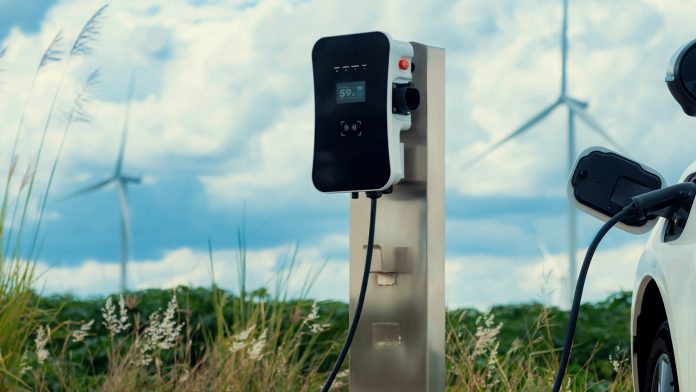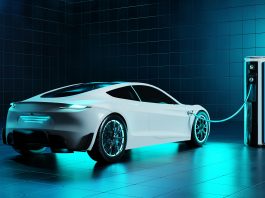Expanding electric vehicle infrastructure in the US is confronted by various issues from governance to location. Here we explore the issues and how they can be combated.
The evolution and expansion of electric vehicle (EV) infrastructure, encompassing both on-road charging stations and off-highway electrification, is a burgeoning topic in the United States. This issue has been characterised by significant regional disparities, with varying levels of availability across different parts of the country.
Furthermore, it is marked by distinct challenges that arise in urban versus rural settings as well as on- and off-road contexts. The role of government support and policy direction also comes into play in shaping this landscape.
As interest in electric vehicles continues to surge, understanding the intricacies behind their supporting infrastructure becomes increasingly crucial. Off-highway electric vehicles have their own unique set of requirements when it comes to charging infrastructure, presenting numerous design and manufacturing challenges.
Looking ahead, predicting future trends within this area is challenging due to its rapidly evolving nature but nonetheless vital for planning and strategising growth trajectories within this realm.
Availability of EV infrastructure in the US
The uneven distribution of electric vehicle charging stations across the United States underscores a significant disparity, with coastal areas generally boasting greater availability than their counterparts in the Midwest and rural regions.
This can be attributed to several factors, including regional disparities in both population density and average income level, which directly influence infrastructure cost and consumer adoption rates of EV technology.
For instance, densely populated urban centres, particularly those along the coasts such as New York City or San Francisco, tend to have higher per capita incomes. These areas are more likely to invest in expensive EV technology and support the infrastructure costs associated with establishing charging stations.
The increased presence of these facilities subsequently encourages more consumers within these regions to adopt electric vehicles due to decreased concerns over charging time.
In contrast, regions characterised by lower population densities or average income levels –such as many Midwestern states and rural areas – are typically less equipped with EV charging infrastructure. This results from a combination of factors: reduced consumer demand for EV technology due to financial constraints; longer distances between destinations that increase concern over charging times; and higher per-unit infrastructure costs arising from the need for more extensive grid enhancements in less developed areas.
As such, despite growing national interest in reducing carbon emissions through transitioning towards electric vehicles, these challenges contribute significantly towards regional disparities in the availability of EV charging stations across America.
Thus, it is imperative that future efforts aimed at expanding this crucial segment of green transportation infrastructure consider these distinctive geographical characteristics and obstacles.
The challenges of expanding EV charging infrastructure
Significant stumbling blocks surface when scrutinising the surge in electric vehicle utilisation, particularly pertaining to potential power supply problems, prohibitive price points of charging stations, and a paucity of policies promoting progress. These issues include:
Infrastructure costs
The establishment of an extensive network of charging stations necessitates substantial capital outlay from both public and private sectors. The latter’s involvement is critical since government funding alone may not suffice.
Technological limitations
Current technology restricts rapid mass-charging capabilities, potentially leading to power grid stress during peak demand periods. This limitation necessitates additional investments in technology development and grid reinforcements.
Public awareness
Despite growing interest in electric vehicles, many potential users remain uninformed about their benefits or how to utilise existing EV infrastructure effectively.
Sustainability concerns
While electric vehicles significantly reduce greenhouse gas emissions compared to conventional fuel cars, the production process itself can have a substantial environmental footprint largely due to battery manufacturing processes.

The availability of EV infrastructure in rural and urban areas
Differences in the accessibility and utilisation of EV charging stations between rural and urban areas presents a nuanced challenge in promoting wider adoption of this sustainable mode of transportation. Rural EV adoption faces obstacles such as a lack of public charging infrastructure due to less population density and greater travel distances.
Moreover, financial considerations play into these disparities as well; the high cost associated with installation and maintenance of charging stations may not be justified by the potential low usage in rural settings. This situation leads to EV accessibility being heavily skewed towards urban regions where there is higher demand.
On the other hand, urban planning challenges also arise in expanding EV infrastructure within cities. The densely populated nature of urban environments results in space constraints for installing new charging stations. Available funding also becomes a critical factor – adequate EV infrastructure funding is necessary for both construction and operation of sufficient charging facilities to meet growing demands.
Additionally, differences between these two types of geographies are reflected not only on human mobility but also have an impact on the environment.
While increased use of electric vehicles can significantly reduce greenhouse gas emissions in densely populated cities, achieving similar outcomes in rural areas can prove much more difficult due to their unique characteristics.
Government support
In light of these challenges, it is noteworthy to mention the initiatives taken by American governmental bodies to bolster the proliferation and accessibility of charging amenities for electric vehicles. The US Government has employed a mixture of methods to support this development:
Federal incentives
At the federal level, several incentives have been introduced over recent years to encourage EV adoption. For instance, the Electric Drive Vehicle Battery and Component Manufacturing Initiative provided $2bn in grants for manufacturing of advanced batteries and electric drive components.
Private partnerships
On top of direct funding, the US government also fosters private partnerships aiming at enhancing electric vehicle infrastructure. An example would be the ‘EV Everywhere Grand Challenge’, launched by the Department of Energy (DOE), which works with national laboratories, universities, private industries and other governmental agencies to increase availability of high-speed charging stations across country.
Infrastructure financing
Additionally, there are efforts directed at infusing capital into public charging infrastructure through financing programmes like the Clean Cities Alternative Fuel Vehicle Deployment Initiatives which allocated millions towards building EV charging stations nationwide.
Technological advancements and environmental impact
Given that environmental impact is a key driver behind the shift towards electric vehicles, governmental policies are expanding physical infrastructure but also investing in research & development for technological advancements that could reduce emissions further while improving EV range and battery life.
Developing off-highway EV charging infrastructure
The development of charging facilities for electric vehicles designed for non-highway use represents a unique and complex challenge, necessitating innovative solutions and strategies. Off-highway adaptations require not only the installation of charging stations in remote or less accessible areas but also the incorporation of infrastructure financing to support their construction and maintenance.
Technological advancements have been pivotal in addressing these challenges, making it feasible to develop energy-efficient charging systems that can withstand harsh environmental conditions while providing reliable service. These advancements range from solar-powered charging stations to smart grid technologies that optimise electricity usage during off-peak hours.
Investing in this type of infrastructure is critical for promoting sustainable solutions within the transportation sector, particularly in industries such as mining, agriculture, and construction where off-road vehicles are prevalent. The integration of renewable energy sources with charging infrastructure offers dual benefits: reducing greenhouse gas emissions associated with traditional fossil fuel-based power generation and extending the reach of EV technology into areas beyond urban centres.
Furthermore, public-private partnerships offer potential avenues for securing necessary funding without placing undue financial burden on local communities or individual businesses.
As such, developing an efficient and resilient off-road EV charging network requires a holistic approach incorporating technological innovation, targeted investment strategies, and sustainability considerations.

The challenges of designing and manufacturing off-highway EVs
Designing and manufacturing electric off-highway vehicles presents unique challenges, with research indicating that a significant one is ensuring these machines can withstand the rigors of heavy-duty applications, an issue reported by 60% of manufacturers. Battery longevity is a critical concern in this regard since off-road vehicles often operate in extreme conditions that could quickly diminish battery life.
Similarly, terrain adaptability is another challenge. Electric vehicles must be designed to handle diverse terrains, from rocky landscapes to sandy dunes, without compromising on performance or energy efficiency.
Material sourcing poses yet another problem due to the need for lightweight but highly durable materials for construction. This brings us to durability concerns which are paramount because unlike regular city electric cars, off-highway EVs have to endure harsher operational conditions requiring them to be more robust and longer-lasting.
Finally, cost efficiency continues being an obstacle as developing high-performance, yet affordable electric off-highway vehicles remains a struggle for many manufacturers, due to high costs associated with batteries and other essential components.
The future of EV infrastructure both on- and off-road
Transitioning from the challenges of designing and manufacturing electric off-highway vehicles, it is pivotal to envision what the future holds for EV infrastructure. This includes both on- and off-road contexts, as each comes with its unique set of considerations pertaining to infrastructure financing, renewable energy integration, vehicle-to-grid technology, and battery disposal methods.
The future landscape of EV infrastructure will likely be shaped by a variety of factors. The pace at which this change occurs may largely hinge upon infrastructure financing – securing sufficient funds to create an expansive network of charging stations that facilitate higher EV adoption rates. As more consumers opt for electric vehicles, there will be an increased demand for reliable and accessible charging facilities.
Therefore, investment in this sector is crucial not only for supporting current users but also promoting further uptake.
Simultaneously, the integration of renewable energy sources into these infrastructures represents a crucial aspect. By harnessing power from sustainable resources such as solar or wind energy, the environmental impact can be further mitigated while optimising energy usage overall.
Moreover, vehicle-to-grid technology presents another promising avenue where electric cars do not just draw power but can feed surplus back into the grid during peak demand hours – thereby acting as mobile energy storage units. This could revolutionise how electricity grids operate while offering additional revenue streams for EV owners.
Lastly are considerations regarding battery disposal methods. With growing numbers of electric vehicles on- and off-road comes increased volumes of spent batteries which necessitate effective recycling or disposal strategies to minimise environmental harm and potential resource losses.
Thus, these aspects collectively indicate a multifaceted future wherein technological advancements must go together with strategic planning and responsible practices.
The US Government’s solutions offer hope
In conclusion, the path to an electrified future, both on- and off-road, resembles a vast and uncharted road. Despite challenges such as regional disparities in charging station availability, hurdles in infrastructure expansion, and manufacturing complexities for off-highway vehicles, progress is being made.
The US Government’s support, alongside innovative solutions, offers hope that these obstacles can be overcome. As the dawn breaks on this new era of transportation, one cannot help but feel a sense of anticipation for what lies ahead – a highway illuminated by the promise of sustainable mobility.
Please note, this article will also appear in the sixteenth edition of our quarterly publication.









